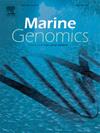Complete genome of Thalassotalea piscium NK451B, an Antarctic bacterium with abundant extracellular proteases
IF 1.5
4区 生物学
Q4 GENETICS & HEREDITY
引用次数: 0
Abstract
Thalassotalea piscium NK451B is a cold-adapted marine bacterium isolated from Antarctic red algae, exhibiting remarkable extracellular proteolytic activity against gelatin, casein, and collagen. In this study, we present the complete genome sequence of strain NK451B, which consists of a single circular chromosome of 4,233,832 bp with a G + C content of 36.79 % and no plasmid. Genome annotation revealed 3776 predicted protein-coding genes, 67 tRNA genes, and 16 rRNA genes. Functional analysis using the MEROPS database identified 73 putative protease-encoding genes, including 50 predicted intracellular proteases and 23 predicted extracellular proteases based on signal peptide analysis. These proteases are classified into five categories based on their catalytic types, with metalloproteinases and serine proteases being the most prevalent. These enzymes are presumed to contribute to the strain's adaptation by enabling the degradation of environmental proteins as sources of carbon and nitrogen. Overall, the genomic insights highlight the biotechnological potential of Thalassotalea piscium NK451B and enhance our understanding of its ecological role in Antarctic marine environments.
一种具有丰富胞外蛋白酶的南极细菌——海带藻NK451B的全基因组
Thalassotalea piscium NK451B是一种从南极红藻中分离出来的冷适应海洋细菌,对明胶、酪蛋白和胶原蛋白具有显著的胞外蛋白水解活性。在本研究中,我们获得了菌株NK451B的全基因组序列,该序列由一条长4,233,832 bp的单圆形染色体组成,G + C含量为36.79%,无质粒。基因组注释显示3776个预测蛋白编码基因,67个tRNA基因和16个rRNA基因。使用MEROPS数据库进行功能分析,确定了73个假定的蛋白酶编码基因,其中50个预测细胞内蛋白酶,23个基于信号肽分析预测细胞外蛋白酶。这些蛋白酶根据其催化类型可分为五类,以金属蛋白酶和丝氨酸蛋白酶最为普遍。这些酶被认为有助于菌株的适应,通过使环境蛋白质的降解作为碳和氮的来源。总体而言,基因组学的见解突出了Thalassotalea piscium NK451B的生物技术潜力,并增强了我们对其在南极海洋环境中的生态作用的理解。
本文章由计算机程序翻译,如有差异,请以英文原文为准。
求助全文
约1分钟内获得全文
求助全文
来源期刊

Marine genomics
生物-遗传学
CiteScore
3.60
自引率
5.30%
发文量
50
审稿时长
29 days
期刊介绍:
The journal publishes papers on all functional and evolutionary aspects of genes, chromatin, chromosomes and (meta)genomes of marine (and freshwater) organisms. It deals with new genome-enabled insights into the broader framework of environmental science. Topics within the scope of this journal include:
• Population genomics and ecology
• Evolutionary and developmental genomics
• Comparative genomics
• Metagenomics
• Environmental genomics
• Systems biology
More specific topics include: geographic and phylogenomic characterization of aquatic organisms, metabolic capacities and pathways of organisms and communities, biogeochemical cycles, genomics and integrative approaches applied to microbial ecology including (meta)transcriptomics and (meta)proteomics, tracking of infectious diseases, environmental stress, global climate change and ecosystem modelling.
 求助内容:
求助内容: 应助结果提醒方式:
应助结果提醒方式:


